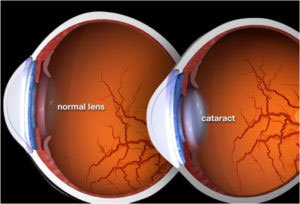
Cataract

Our eye contains a small lens, which consists mainly of water and proteins. This lens rests almost in the center of the eyeball, just behind the pupil, and serves to focus light rays coming from the external environment onto the retina. This lens is naturally crystal clear. Its clouding from various causes is called a cataract. Cataracts appear after the age of 50, but can occur at any age, even in infants and children (there is rare congenital cataract, where the baby is born with a cloudy lens).
Symptoms
- Progressive vision loss that is not corrected by glasses
- Strong blur in light
- Fading or yellowing of colors
- Circles around the lights
- Appearance of myopia after 30 years
Sometimes early stage cataracts improve near vision without glasses. Advanced cataracts can even lead to blindness.
Cause
- Old age
- Radiations
- Eye injury
- Long-term use of cortisone and other drugs
- Diabetes mellitus
- Ophthalmic operations, such as vitrectomy or glaucoma surgery, etc.
- Ophthalmological operations, such as vitrectomy or glaucoma surgery In the rare case of congenital cataract, various causes affect during pregnancy and the baby may be born with a cataract (congenital cataract), etc.
Treatment
There are no medications or eye drops that can cure cataracts, surgery is the only treatment. The microsurgical restoration of the clarity of the lens, now called phacotripsy, is the solution for cataracts. With the instillation of local anesthetic drops, we make 2 small incisions (2.2 mm / 1.0 mm) in the eye (cornea) and in the place of the natural lens that is cloudy, an intraocular lens is placed, it does not need the use of sutures, it is painless and does not require a stay in clinic. This can sometimes be done at the same time as the correction of any refractive errors of the eye (myopia, hypermetropia, astigmatism or presbyopia).
Postoperative Control
- Measurement of the axial length of the eye with the new state-of-the-art laser biometry, for the calculation of the artificial lens
- Measurement of corneal endothelial cells to determine the type of operation
- Optical macular tomography to reveal underlying conditions and to predict the vision that will be achieved postoperatively
Intraocular
The intraocular lens that is placed in place of the natural lens that is cloudy (cataract), is a small artificial lens.
There is a wide range of intraocular lenses:
- Monofocal intraocular lens (to correct far vision)
- Monofocal toric intraocular lens (for correction of corneal astigmatism and distance vision)
- BIFOCAL Intraocular Lens (is a special intraocular lens that has multiple focal points for correction of distance, intermediate, and near distance). For correction of myopia or hyperopia, and presbyopia
- TRIFOCAL Intraocular Lens (it is a special intraocular lens that has multiple focal points for correction of distance, intermediate, and near distance). For correction of myopia or hyperopia, and presbyopia.
- BIFOCAL TORIC Intraocular Lens (is a special intraocular lens that has multiple focal points for distance, intermediate, near distance correction and for corneal astigmatism correction). For correction of myopia or hyperopia, astigmatism and presbyopia.
- TRIFOCAL TORIC Intraocular Lens (is a special intraocular lens that has multiple focal points for distance, intermediate, near distance correction and for corneal astigmatism correction). For correction of myopia or hyperopia, astigmatism and presbyopia.
The success rate of cataract surgery is very high at 94%. However, there is also a complication rate of around 6%.
